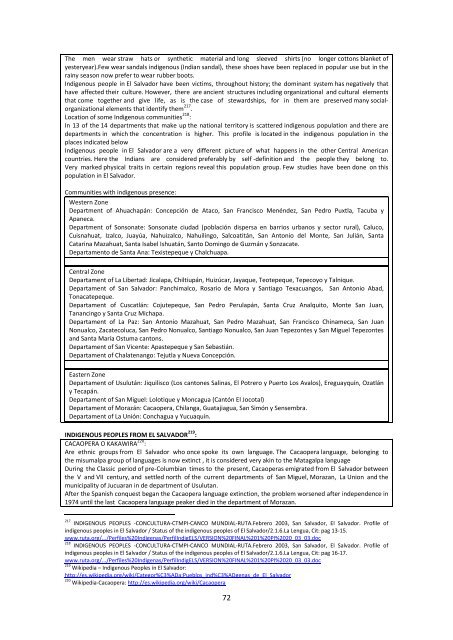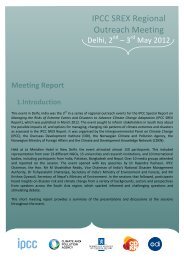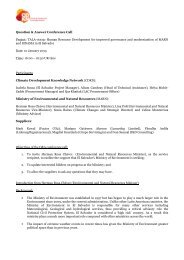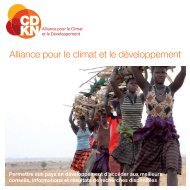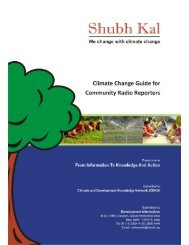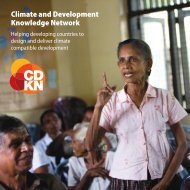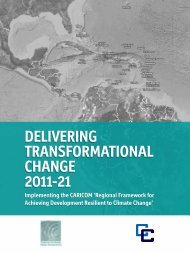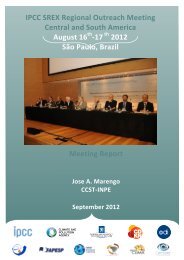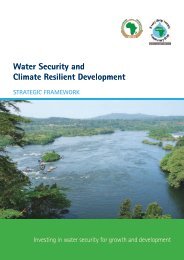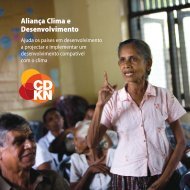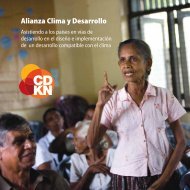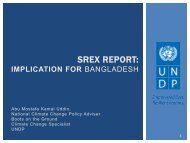The men wear straw hats or synthetic material and long sleeved shirts (no longer cottons blanket ofyesteryear).Few wear sandals indigenous (Indian sandal), these shoes have been replaced in popular use but in therainy season now prefer to wear rubber boots.Indigenous people in El Salvador have been victims, throughout history; the dominant system has negatively thathave affected their culture. However, there are ancient structures including organizational and cultural elementsthat come together and give life, as is the case of stewardships, for in them are preserved many socialorganizationalelements that identify them 217 .Location of some Indigenous communities 218 :In 13 of the 14 departments that make up the national territory is scattered indigenous population and there aredepartments in which the concentration is higher. This profile is located in the indigenous population in theplaces indicated belowIndigenous people in El Salvador are a very different picture of what happens in the other Central Americancountries. Here the Indians are considered preferably by self -definition and the people they belong to.Very marked physical traits in certain regions reveal this population group. Few studies have been done on thispopulation in El Salvador.Communities with indigenous presence:Western ZoneDepartment of Ahuachapán: Concepción de Ataco, San Francisco Menéndez, San Pedro Puxtla, Tacuba yApaneca.Department of Sonsonate: Sonsonate ciudad (población dispersa en barrios urbanos y sector rural), Caluco,Cuisnahuat, Izalco, Juayúa, Nahuizalco, Nahuilingo, Salcoatitán, San Antonio del Monte, San Julián, SantaCatarina Mazahuat, Santa Isabel Ishuatán, Santo Domingo de Guzmán y Sonzacate.Departamento de Santa Ana: Texistepeque y Chalchuapa.Central ZoneDepartament of La Libertad: Jicalapa, Chiltiupán, Huizúcar, Jayaque, Teotepeque, Tepecoyo y Talnique.Departament of San Salvador: Panchimalco, Rosario de Mora y Santiago Texacuangos, San Antonio Abad,Tonacatepeque.Departament of Cuscatlán: Cojutepeque, San Pedro Perulapán, Santa Cruz Analquito, Monte San Juan,Tanancingo y Santa Cruz Michapa.Departament of La Paz: San Antonio Mazahuat, San Pedro Mazahuat, San Francisco Chinameca, San JuanNonualco, Zacatecoluca, San Pedro Nonualco, Santiago Nonualco, San Juan Tepezontes y San Miguel Tepezontesand Santa María Ostuma cantons.Departament of San Vicente: Apastepeque y San Sebastián.Departament of Chalatenango: Tejutla y Nueva Concepción.Eastern ZoneDepartament of Usulután: Jiquilisco (Los cantones Salinas, El Potrero y Puerto Los Avalos), Ereguayquín, Ozatlány Tecapán.Departament of San Miguel: Lolotique y Moncagua (Cantón El Jocotal)Departament of Morazán: Cacaopera, Chilanga, Guatajiagua, San Simón y Sensembra.Departament of La Unión: Conchagua y Yucuaquín.INDIGENOUS PEOPLES FROM EL SALVADOR 219 :CACAOPERA O KAKAWIRA 220 :Are ethnic groups from El Salvador who once spoke its own language. The Cacaopera language, belonging tothe misumalpa group of languages is now extinct , it is considered very akin to the Matagalpa languageDuring the Classic period of pre-Columbian times to the present, Cacaoperas emigrated from El Salvador betweenthe V and VII century, and settled north of the current departments of San Miguel, Morazan, La Union and themunicipality of Jucuaran in de department of Usulutan.After the Spanish conquest began the Cacaopera language extinction, the problem worsened after independence in1974 until the last Cacaopera language peaker died in the department of Morazan.217 INDIGENOUS PEOPLES -CONCULTURA-CTMPI-CANCO MUNDIAL-RUTA.Febrero 2003, San Salvador, El Salvador. Profile ofindigenous peoples in El Salvador / Status of the indigenous peoples of El Salvador/2.1.6.La Lengua, Cit: pag 13-15.www.ruta.org/.../Perfiles%20Indigenas/PerfilIndigELS/VERSION%20FINAL%201%20PI%2020_03_03.doc218 INDIGENOUS PEOPLES -CONCULTURA-CTMPI-CANCO MUNDIAL-RUTA.Febrero 2003, San Salvador, El Salvador. Profile ofindigenous peoples in El Salvador / Status of the indigenous peoples of El Salvador/2.1.6.La Lengua, Cit: pag 16-17.www.ruta.org/.../Perfiles%20Indigenas/PerfilIndigELS/VERSION%20FINAL%201%20PI%2020_03_03.doc219 Wikipedia – Indigenous Peoples in El Salvador:http://es.wikipedia.org/wiki/Categor%C3%ADa:Pueblos_ind%C3%ADgenas_de_El_Salvador220 Wikipedia-Cacaopera: http://es.wikipedia.org/wiki/Cacaopera72
Currently Cacaopera ethnicity, although their language is extinct, still maintain their traditions and customs, one ofthem is the Dance of the emplumados (the feathered). They are represented by the organization called Winaka. Amuseum is dedicated to the culture or Kakawira located in the municipality of Cacaopera.LENCA 221 :It is a Mesoamerican ethnic group that has its own language, which occupied part of the territory of Hondurasand El Salvador since pre-Columbian times.His affiliation with other languages is in dispute among linguists. According to Campbell, the Lenca language is notyet rated. According to the Costa Rican linguist Costenla Adolfo Umaña, is a language with chibchano roots, butwith much influence from the Nahuatl andMayan languages like Yucatec and Chol.PIPILES 222 :The Pipil are indigenous people inhabiting the western and central El Salvador. Its language is Pipil or Nahuatl. Theancestors of the Pipil emigrated from Mexico and settled in what is now El Salvador in the tenth century ADPipiles branches are:The Cuscatlecos, who lived in Cuscatlan (now the town of Antiguo Cuscatlan in San Salvador area).The Izalcos that harvested cocoa and traded obsidian toolsNonualcos, who were known to be fond of war.The Mazahuas, who raised herds of white-tailed deer.XINCA 223 :The Xinca people are a Native American ethnic, almost extinct, which was located in Central America, in what isnow Guatemala and El Salvador. They were characterized by speaking the language Xinca of unknown family andnot related to the Aztec.LEGAL RECOGNITION OF THE INDIGENOUS PEOPLESIn El Salvador, there is still no constitutional recognition of indigenous peoples' rights, especially with regard tocollective rights, ie the use of language, the right to identity, the presence of his own regulatory traditional system.The Constitution of El Salvador (Constitution of the Republic) expressed in its content that there is nodiscrimination for the residents in the territory of the Republic, a fact which was ratified with the signing of peaceaccords in Chapultepec Mexico, January 16, 1992, in order to ensure the protection of human rights andset properly the powers of state bodies and legal powers which highlights the principles, rights and obligations andaims, the pursuit of justice, legal certainty and the common good.All this was managed in a holistic manner. These instruments, though, are of vital importance to the system oflaw prevailing in the country, have not taken into account the specificity and worldview of indigenous peoples andcommunities. It has been ignoring the indigenous law.The Constitution of El Salvador recognizes the principle of legal equality, which determines that the enjoyment ofcivil rights there may be not established restrictions based on differences of nationality, race, sex or religion,Article 3 NC, under which the Constitution has previously recognized the individual as the origin and purpose ofstate activity and indicates that the purpose of that is the constitution of justice, legal certainty and the commongood 224 .Indigenous Law and its practices:Indigenous peoples historically exercised their own justice system, by which, retaining their values, customs,forms of organization and conflict resolution mechanism and implementation of justice. In some indigenouspeoples still prevails this ancestral justice system.The use of the terms and customs, legal practice and even customary law, indigenous law prevails, being aproprietary system, through which justice is delivered.In El Salvador there are villages where in spite of modern legislation, they maintain the traditions and ancestralcustoms that form a sort of common law and is preserved over time. Examples include the mayors ofthe communities, whose main functions are conciliatory and of spiritual character. In this way they make decisionsto benefit their community and participate in the appointment of officers of guilds.In this structure, each of the first members of a guild is part of a civil ceremonial council power. The positions ofindividuals within the council are nested according to the position he occupies in the inter guilds hierarchy, ie, thepatron saint who represents the member.This council made up of members who along with mayors appoint the mayors of all the guilds, controls the festivalcalendar and supervise the finances of the guilds. Another function is to meet with city officials and leaders of the221 Wikipedia-Lenca: http://es.wikipedia.org/wiki/Lenca222 Wikipedia-Pipil:http://es.wikipedia.org/wiki/Pipil223 Wikipedia-Xinca: http://es.wikipedia.org/wiki/Xinca224INDIGENOUS PEOPLES-CONCULTURA-CTMPI-CANCO MUNDIAL-RUTA. February 2003, San Salvador, El Salvador. Profileof indigenous Peoples in El Salvador / VI. Legal Framework / Legal Framework of the Indigenous peoples in El Salvador /6.4 LegalInstruments.6.4.2 international Instruments Cit: pag 10-15:www.ruta.org/.../Perfiles%20Indigenas/PerfilIndigELS/VERSION%20FINAL%201%20PI%2020_03_03.doc73
- Page 3 and 4:
Executive SummaryCentral America is
- Page 5 and 6:
Central is located in the "Ring of
- Page 7 and 8:
Study ContentAs an innovative theme
- Page 9 and 10:
that coexist in the universe. This
- Page 11 and 12:
Central America level, is the only
- Page 13 and 14:
of Mesoamerica has been explained a
- Page 15 and 16:
possesses effective cultural commun
- Page 17 and 18:
Additionally, to succeed and achiev
- Page 19 and 20:
eforestation, hydrological planning
- Page 21 and 22: General thematic introduction on Cl
- Page 23 and 24: Central American Governments should
- Page 25 and 26: projected 109 conditions, changes o
- Page 27 and 28: General introduction on the themati
- Page 29 and 30: participatory manner, to address di
- Page 31 and 32: Causes and complementary consequenc
- Page 33 and 34: Organizational and legal contextWhi
- Page 35 and 36: The three bodies within the SICA ar
- Page 37 and 38: Based on research of available info
- Page 39 and 40: SE-CONREDCivilProtectionSNETCCNISCO
- Page 41 and 42: Synergy model that displays the add
- Page 43 and 44: Added value of indigenous and local
- Page 45 and 46: They do not work in a separate mann
- Page 47 and 48: demand for agricultural raw materia
- Page 49 and 50: Amazon DIPECHO Project “Strengthe
- Page 51 and 52: Indigenous Knowledge on DisasterMit
- Page 53 and 54: The combination of indigenous andsc
- Page 55 and 56: Indigenous Skills and the mysticism
- Page 57 and 58: Weather forecast through indigenous
- Page 59 and 60: In various international convention
- Page 61 and 62: Recommended ReadingBennett, A., 200
- Page 63 and 64: ILO, 1993, Convenio sobre pueblos i
- Page 65 and 66: Local knowledgeIncludes people and
- Page 67 and 68: which are threatswith a certainprob
- Page 69 and 70: Appreciates and respects their orga
- Page 71: framework, without taking into acco
- Page 75 and 76: IDH 228 For 2007 is of 0.6999Politi
- Page 77 and 78: The Mayangnas are people who are de
- Page 79 and 80: Rights of detainees to receive info
- Page 81 and 82: Heritage Protection Article 128The
- Page 83 and 84: 19/09/1996 Law no. 230 Amendments a
- Page 85 and 86: Indigenous Population:IDH 241 In 20
- Page 87 and 88: Honduras, each has a different orig
- Page 89 and 90: MISQUITOS 248 :In 1996 there were 3
- Page 91: Internationalconventions signed wit


